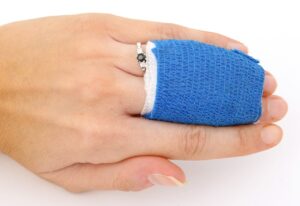Written by Harold Oster, MD. Results show that topical application of a hydrogel containing licorice root may accelerate the healing of second-degree burns.
 Burns are common injuries, with approximately one million cases each year in the United States and over 8 million per year globally1,2. Classification of burns has traditionally been based on the depth of the injury, with second-degree burns involving the epidermis and the dermis. Most second-degree burns, particularly if they involve less than 10% of the body, are managed in the outpatient setting with dressings and topical agents3.
Burns are common injuries, with approximately one million cases each year in the United States and over 8 million per year globally1,2. Classification of burns has traditionally been based on the depth of the injury, with second-degree burns involving the epidermis and the dermis. Most second-degree burns, particularly if they involve less than 10% of the body, are managed in the outpatient setting with dressings and topical agents3.
Licorice, Glycyrrhiza glabra, contains numerous bioactive compounds, including glycyrrhizin, glycyrrhetinic acid, and various flavonoids. Licorice and many of the individual compounds have been shown to have anti-inflammatory, antibacterial, and antiviral effects4-6. Licorice extract has been shown to accelerate excisional wound healing in vivo7.
Mohsen Zabihi, et al studied the potential beneficial effects of topical licorice extract on the healing of second-degree burns in humans. Fifty-four burn victims were randomly assigned a placebo hydrogel or one containing licorice extract. A hydrogel was prepared with 0.4g of 940 carbomer, 100 ml of distilled water, 8-10 drops of triethanolamine, 5 ml of glycerin, and 0.15g of methylparaben. Licorice extract was added to the mixture to create a 5% licorice hydrogel. Identical hydrogel without licorice was used as a control.
All patients had second-degree burns involving less than 15% of their body surface. They received the licorice hydrogel or placebo twice a day for fifteen days, and the burned areas were assessed on days 1, 3, 6, 10, and 15 for pain intensity, burning, redness, and inflammation by standard scoring methods.
The authors noted the following:
- The demographics of the two groups of patients were similar, as were the causes of the burns.
- The average extent of the burns, assessed as a percentage of body surface area, was higher in the intervention group. (5.5% vs. 3.6%)
- On day 1, redness was greater in the placebo group.
- By the end of the study, all patients in both groups had improved. On the final day, the participants who received licorice hydrogel had an improved wound appearance compared to the placebo group.
- By day 6, the group that received licorice hydrogel had more significant improvement than the placebo group in pain, burning, inflammation, and redness.
Results of the study suggest a benefit of topical licorice in a hydrogel in the healing of second-degree burns in humans. A limitation of the study is that the licorice group had more extensive burns than the placebo group. This is unlikely to have caused or increased the apparent benefit of the licorice.
Source: Zabihi, Mohsen, Bahareh Hatefi, Mohammad Ebrahimzadeh Ardakani, Ali Mohammad Ranjbar, and Farhad Mohammadi. “Impact of licorice root on the burn healing process: A double-blinded randomized controlled clinical trial.” Complementary Therapies in Medicine 73 (2023): 102941.
© 2023 The Authors. Published by Elsevier Ltd. This is an open access article under the CC BY license (http://creativecommons.org/licenses/by/4.0/).
Click here to read the full text study.
Posted June 7, 2023.
Harold Oster, MD graduated from medical school in Miami, Florida in 1992 and moved to Minnesota in 2004. After more than 25 years of practicing Internal Medicine, he recently retired. Dr. Oster is especially interested in nutrition, weight management, and disease prevention. Visit his website at haroldoster.com.
References:
- Brigham PA, McLoughlin E. Burn incidence and medical care use in the United States: estimates, trends, and data sources. J Burn Care Rehabil. Mar-Apr 1996;17(2):95-107. doi:10.1097/00004630-199603000-00003
- Yakupu A, Zhang J, Dong W, Song F, Dong J, Lu S. The epidemiological characteristic and trends of burns globally. BMC Public Health. Aug 22 2022;22(1):1596. doi:10.1186/s12889-022-13887-2
- Mertens DM, Jenkins ME, Warden GD. Outpatient burn management. Nurs Clin North Am. Jun 1997;32(2):343-64.
- Leite CDS, Bonafé GA, Carvalho Santos J, Martinez CAR, Ortega MM, Ribeiro ML. The Anti-Inflammatory Properties of Licorice (Glycyrrhiza glabra)-Derived Compounds in Intestinal Disorders. Int J Mol Sci. Apr 8 2022;23(8)doi:10.3390/ijms23084121
- Yang R, Yuan BC, Ma YS, Zhou S, Liu Y. The anti-inflammatory activity of licorice, a widely used Chinese herb. Pharm Biol. Dec 2017;55(1):5-18. doi:10.1080/13880209.2016.1225775
- Wang L, Yang R, Yuan B, Liu Y, Liu C. The antiviral and antimicrobial activities of licorice, a widely-used Chinese herb. Acta Pharm Sin B. Jul 2015;5(4):310-5. doi:10.1016/j.apsb.2015.05.005
- Assar DH, Elhabashi N, Mokhbatly AA, et al. Wound healing potential of licorice extract in rat model: Antioxidants, histopathological, immunohistochemical and gene expression evidences. Biomedicine & pharmacotherapy = Biomedecine & pharmacotherapie. Nov 2021;143:112151. doi:10.1016/j.biopha.2021.112151
